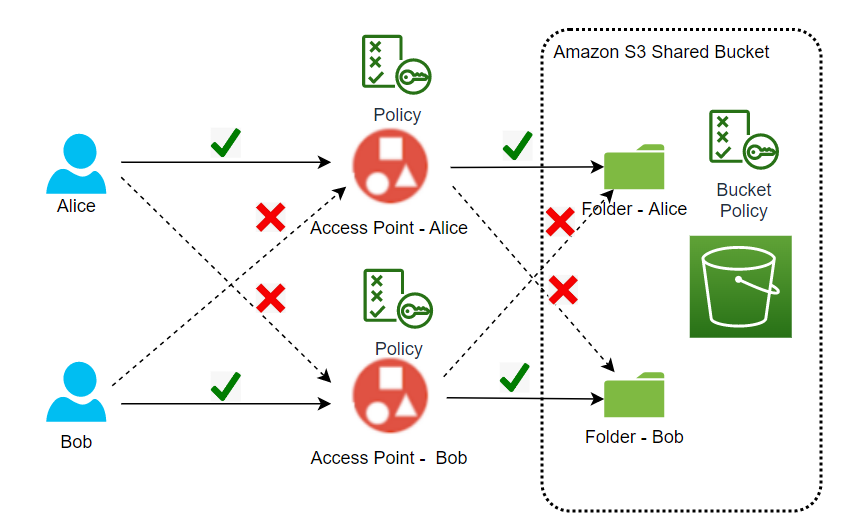Amazon S3 Access Points are a feature that simplify managing access to S3 buckets. They provide a way to create specific access permissions for applications that need to interact with your S3 bucket, allowing you to manage access at a granular level.

Key Concepts of S3 Access Points:
-
Access Points Overview:
- An S3 Access Point is associated with a single bucket, and each access point has a unique DNS name that applications use to access the bucket.
- You can create multiple access points for a single S3 bucket, each with its own permissions and network controls.
-
Purpose:
- Simplifies access management for large-scale S3 buckets that serve different applications or users.
- Allows you to define specific policies and network controls per access point, rather than using bucket policies or IAM policies alone.
-
Access Point Policies:
- Each access point can have its own resource policy, specifying who can access the data and under what conditions.
- Policies can control access based on user identity, IP address, VPC, or other conditions.
-
VPC Integration:
- You can create VPC-only access points, restricting access to S3 data to only those requests coming from a specific VPC.
- This is particularly useful for controlling access from within your AWS environment and securing your data from external access.
-
DNS Naming:
- Each access point gets a unique DNS name, which is used in place of the bucket name in S3 requests. This helps in isolating access paths to your bucket.
- Example: If your bucket name is
my-bucketand your access point is namedmy-access-point, the DNS name might look likemy-access-point-123456789012.s3-accesspoint.region.amazonaws.com.
-
Use Cases:
- Isolated Environments: Providing different applications or teams access to the same bucket without giving them access to the entire bucket or needing complex bucket policies.
- Network Control: Restricting access to S3 buckets to certain VPCs or specific IP ranges, improving security by enforcing network-based access restrictions.
- Delegated Permissions: Allowing you to delegate access controls to different teams or departments by providing them with access points, rather than managing permissions centrally.
-
Lifecycle Management:
- Access points can also be used with S3 features like Object Lock, versioning, and lifecycle policies, allowing you to manage data according to your organization’s requirements.
Example Use Case:
Suppose you have a data lake stored in an S3 bucket, and different teams need access to different parts of this data. You can create multiple access points with distinct policies:
- Data Engineering Access Point: Grants full access to all data.
- Analytics Team Access Point: Restricts access to only certain prefixes in the bucket.
- External Partner Access Point: Allows read-only access from specific IP addresses or a VPC.
This approach provides a more flexible, secure, and scalable way to manage S3 bucket access in complex environments.